HMS Dreadnought (BB-1906)
Return to main page:
HMS Dreadnought as a 'fast' Battleship.
(see below for original)
The original HMS Dreadnought was revolutionary in many ways, all big guns,
turbines, it made the rest of the worlds battleships look tame. But, it was only
the first all big gun battleship by being built in such a quick fashion. The US
and Japan both had all big gun ships building and a lot of other nations had
them on the drawing bird. Probably the most innovative of the early battleships
was the South Carolina type with its superfiring turrets. The Royal Navy did not
get to a superfiring turret until the Neptune class.
With this 'Fast' Dreadnought, I have taken Jackie Fishers ideas one step further
than either a dreadnought type (slowish with decent armour) or an Invincible
type (faster with paper armour), with a hybrid of both types, decent armour with
decent speed and an armament that was as good as the original but making better
use of the length of the ship with the superfiring turret. What I have ended up
with seems to be a 'fast' Neptune.
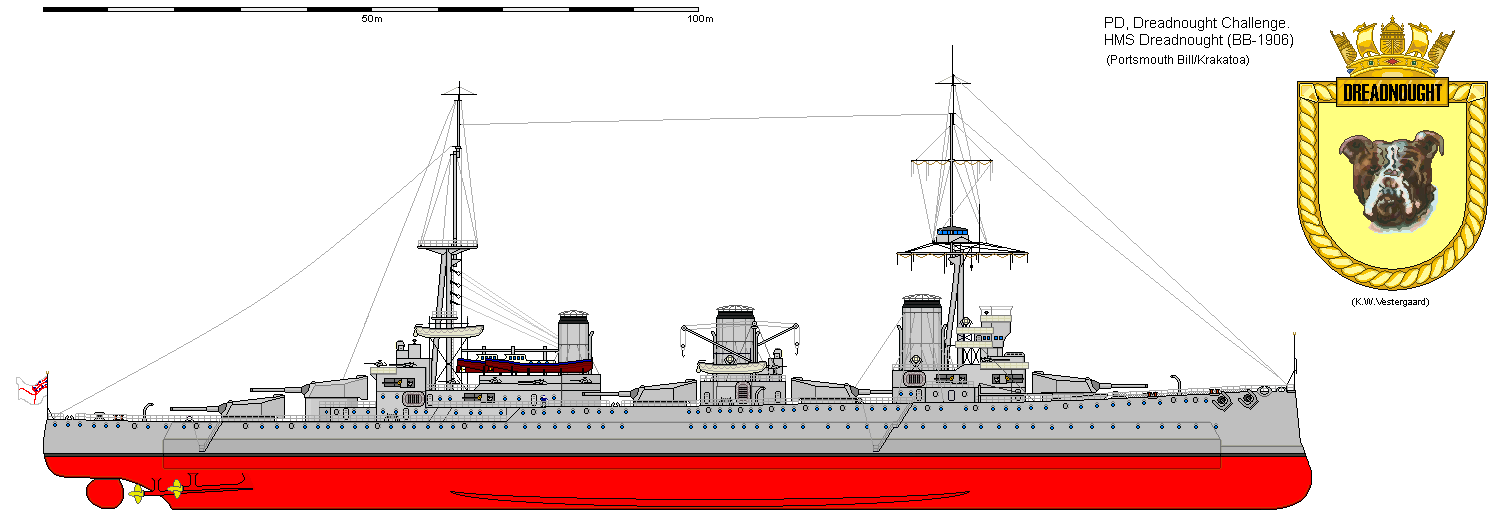
It would still not have been kept as a battleship past 1920 and would have been
discarded in the real world, or kept as an Area Defence Vessel in the
Fissherless RN world. The other thing to follow on with, is if the Dreadnought
becomes a 'fast' battleship then the rest would follow suit. Bellerophon, St
Vincent classes (Dreadnought clones) would be the same, Neptune & Colussus would
be bigger and faster, while the three super-dreadnought classes and the 'R'
Class would also pick up some knots in speed. There would have been no need for
the battlecruisers, no need to repurpose two 'R' class to Repulse and Renown as
you could end up with twelve battleships of the Queen Elizabeth type.
|
HMS Dreadnought as a 'fast' Battleship. |
| Displacement |
20,000 tons standard, 23,250 tons full load |
| Length |
634 ft |
| Breadth |
86 ft |
| Draught |
26 ft |
| Machinery |
4 shaft steam turbines, 45,000shp |
| Speed |
25 knots |
| Range |
6000 miles at 14 knots |
| Armour |
11" side, 2" deck, 10" conning tower, 10"/7"/4"
turrets |
| Armament |
10 x 12" (5x2)
14 x 4" (14x1)
5 x 2pd (5x1) |
| Aircraft |
nil |
| Torpedoes |
nil |
| Complement |
870 (920 as Flagship) |
| Notes |
Sale and scrap 1920-22 |
Aft turrets of HMS Dreadnought as a fast battleship with superfiring turrets
aft.
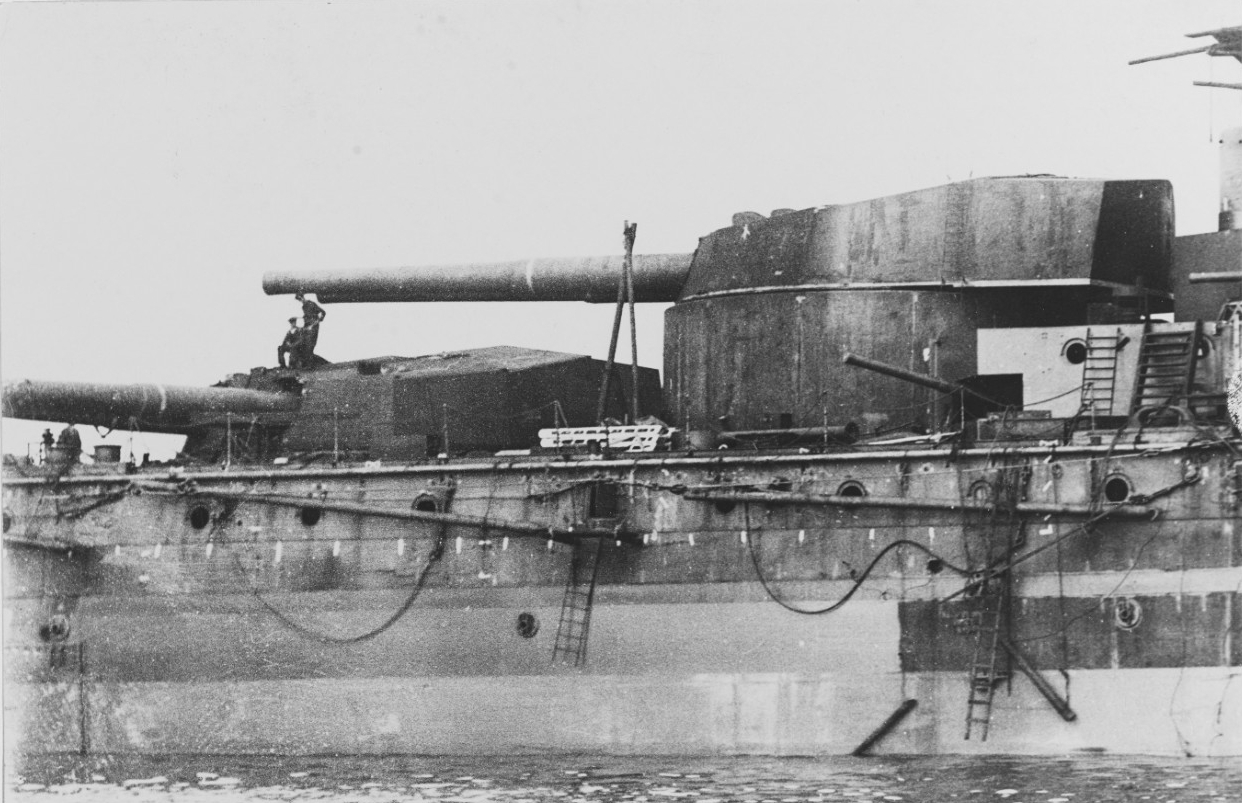
HMS Dreadnought as a Battleship.
HMS Dreadnought put its name to a generation of Battleships. It managed
that by also being the fastest built battleship.
Laid down: 02/Oct/1905, Launched: 10/Oct/1906, Commissioned: 02/Dec/1906.
No other nation could match the speed of building ships the way the British
Empire could. It is not till 1942-43 when the US speed the production of the
Iowa class that any other nation comes close.
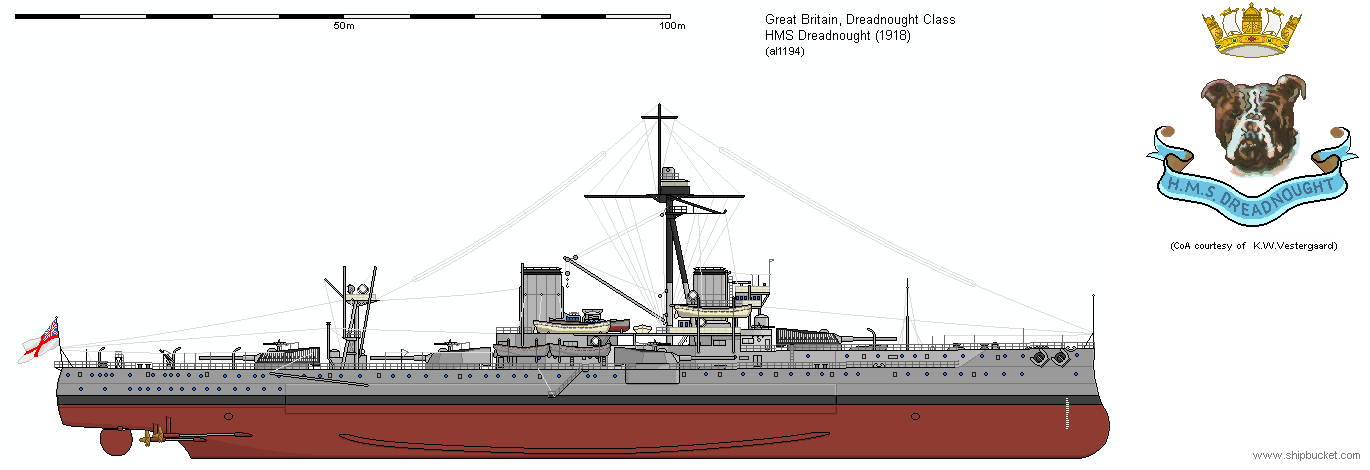
The other main feature to Dreadnought was the fitting of turbine machinery. But
as an advance in technology it was soon outstripped by bigger, better and meaner
ships. In 15 years and a war, the size of dreadnoughts had doubled and the
firepower tripled (or more). That was why when the war ended the Royal Navy was so quick
(in real life) to discard all its 12" gunned ships. Most were less than 10 years
old at wars end but hopelessly obsolete. But, the RN kept a lot of the older
triple expansion engined/coal fired, armoured cruisers as 'training ships'. Why?,
when you could seriously disarm the six Dreadnought and clones (remove three
central turrets and forward boiler room) and have modern ships for those roles.
Which then means at 20 years of age (early 1930's) they can be converted to the
Area Defence Vessels (ADV) and still retain their training roles. With the
Dreadnought, the P, Q and X turrets were removed to leave the ship as not much
more than a pre-dreadnought, and no country was scared of a pre-dreadnought. The
new single 6" turret that was being trialled for fitting to the 'D' class
cruisers (and others) was fitted in replacement of the P and Q turrets, while
the space where X turret had been was converted to accommodation and
offices/classrooms.
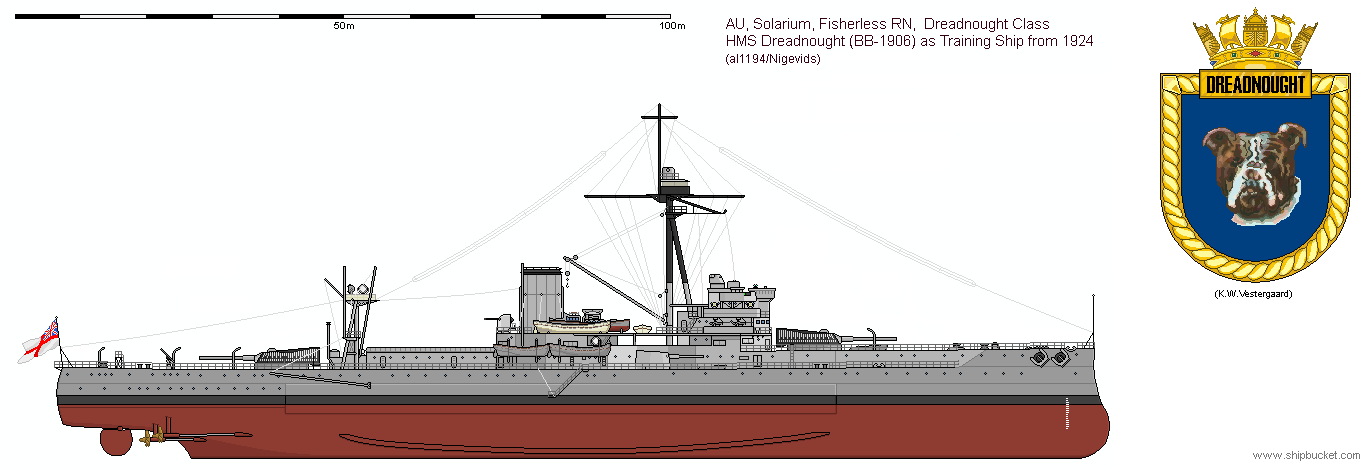
The ADV conversion was to enhance the ships and to make them more valuable. Park
them in a harbour and they would be able to service all sorts of 'squadron'
ships and aircraft. The large hangar aft could be used for a variety of uses of
its own. Cut in half (with plywood) the open end could still house and service
its own seaplanes while the front half could be fitted into dormitories to house
cadets and/or marines. There were many minor uprisings around the world in
Commonwealth countries that were cured by the nearest ADV. Able to provide their
own Marine landing force, air support, and fire support if the problem is near
the sea. The one based on Singapore had many calls to the Commonwealth Pacific
Islands where the warring natives were always a problem. Eventually the
Dreadnought and its clones were all converted to ADV's, only differing in
details.
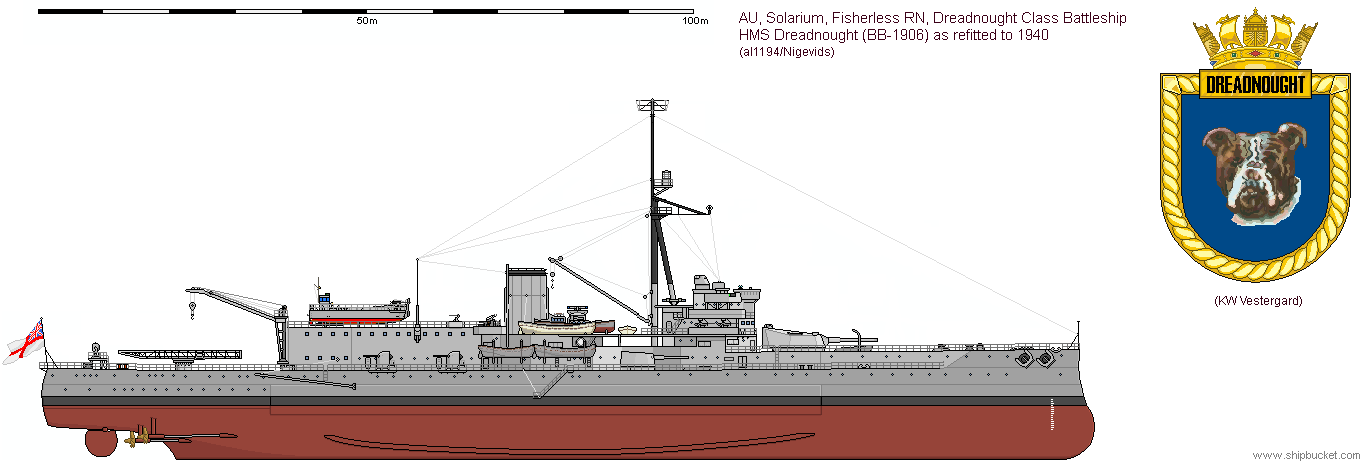
The Dreadnought could carry any of the RN seaplanes from the Walrus to the
Spitfire floatplane. The differing types of seaplanes available was tremendous,
Seafox, Skua/Roc, Swordfish, and then the US variants from 1942+. This meant
that a mix of aircraft could be carried to carry out the different roles for
where the ship was to be based. Being the oldest of the ADV types available the
Dreadnought was sent to Sierra Leone in 1939 and just missed being intercepted
by a German raider on its voyage. It stayed in place at Sierra Leone for the
whole war, servicing everything from Sunderlands, to submarines and destroyers.
Its engineers became adept at fixing the problems and challenges set by these
varied vessels. Most of the aircraft carried of its own were Walrus and
Swordfish types used for local patrols which kept the U-boats away from the
harbour itself. The LCI (Landing Craft Infantry) was used to transport all
manner of stores around the harbour.
|
HMS Dreadnought as a Battleship - Training Ship -
Area Defence Vessel 1906-45. |
| |
Original 1906-1922 |
As TS / ADV 1923-1945 |
| Displacement |
18,500 tons standard, 21,250 tons full load |
| Length |
527 ft |
| Breadth |
82 ft |
| Draught |
28 ft |
| Machinery |
4 shaft steam turbines, 23,000shp |
4 shaft, steam turbines, 18,000shp |
| Speed |
21 knots |
16-17 knots |
| Range |
7000 miles at 10 knots |
8000 miles at 12 knots |
| Armour |
11" side, 2" deck, 10"/7"/4"
turrets |
| Armament |
10 x 12" (5x2)
14 x 4" (14x1)
5 x 2pd (5x1)
|
As Training Ship
4 x 12" (2x2)
2 x 6" (2x1)
1 x 4" AA (1x1)
2 x 3" AA (2x1)
4 x 2pd (4x1) |
As Area Defence Vessel
2 x 12" (1x2)
2 x 6" (2x1)
4 x 4" AA (4x1)
12 x 2pd (2x4 4x1)
|
| Aircraft |
Nil |
Nil |
from 3 to 9 depending on size and role |
| Torpedoes |
5 x 18" (5x1 submerged) |
Nil |
Nil |
| Complement |
870 (920 as Flagship) |
440 + 200 cadets |
450 + Cadets and/or Marines |
| Notes |
Discarded and scrapped 1945. |
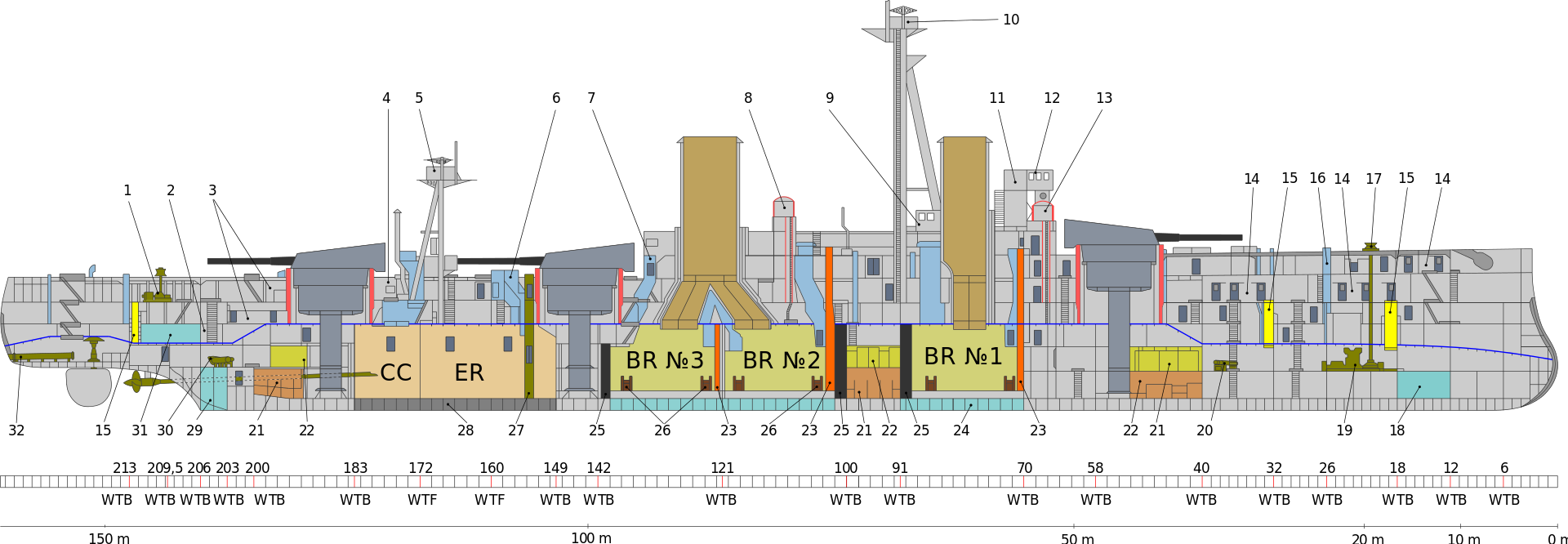
Hull longitudinal section CC – condenser compartment; ER – engine room; BR –
boiler room; WTB – watertight bulkhead; WTF – watertight frame. 1 – after
capstan; 2, 4 – torpedo head magazine; 3 – mess space; 5 – fore top; 6 – engine
room vent; 7 – boiler room vent; 8 – signal tower; 9 – ; 10 – main top; 11 –
admirals sea cabin; 12 – chart house; 13 – conning tower; 14 – officers' cabin;
15 – escape trunk; 16 – vent; 17 – capstan; 18 – trimming tank; 19 – capstan
engine room; 20 – submerged torpedo room; 21 – 12 in shellroom; 22 – 12 in
magazines; 23 – ash hoist; 24 – reserve feed-water tank; 25 – coal bunker; 26 –
coal shute; 27 – electric lift; 28 – oil fuel tank; 29 – fresh water tank; 30 –
submerged torpedo room; 31 – fresh water tank; 32 – stern torpedo tube
Return to main page:





